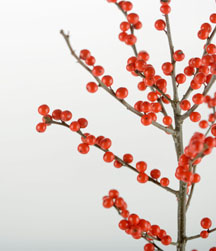Handling garden drainage an ongoing process
by Kristina Gabalski
 Shrubs such as winterberry holly can grow is somewhat wet areas of the garden. The bonus in this example is red berries for winter interest in the yard and for decorations.Water is always an issue in the garden, whether you’re working to provide water in the easiest and most efficient manner during dry times, or whether, like this June, you’ve been watching the garden either explode like a jungle or suffocate in a bog of standing water, it seems nature rarely provides just the right amount of rain to make the garden perfectly happy.
Shrubs such as winterberry holly can grow is somewhat wet areas of the garden. The bonus in this example is red berries for winter interest in the yard and for decorations.Water is always an issue in the garden, whether you’re working to provide water in the easiest and most efficient manner during dry times, or whether, like this June, you’ve been watching the garden either explode like a jungle or suffocate in a bog of standing water, it seems nature rarely provides just the right amount of rain to make the garden perfectly happy.
The abundance of rain this month can be discouraging if areas you’ve planted with vegetable and flower seeds have been washed out or transplants and seeds that have sprouted have died in areas where rainwater has not drained.
Times like this can be helpful, though, too, because they show you exactly where the drainage issues are in your garden or yard so you can work to rectify the situation.
The most serious problems need the most serious attention – digging ditches and laying down drainage pipes or tile – but there are also some easier ways you can work to improve drainage in your garden beds.
For the most part, my perennial beds and vegetable growing beds drain well, despite my predominantly clay soil. The only area that gives me real trouble when
it has been as wet as it has, is the far west end of one of my vegetable/fruit/herb beds which sits in the path of the outflow from our sump pump.
Several years ago, after planting pumpkin seeds in the area only to see them get washed away in heavy rain storms, I worked by hand to raise up the area, simply by digging up and mounding the soil. A trench was created on the edge of the garden, which diverted water away from the planting bed. It has worked well, although I need to repeat the process when necessary due to normal settling of the soil.
Raised beds, created either by mounding up existing soil for planting, or placing a contained raised bed on top of a damp area, can be a great way to deal with drainage problems.
Another helpful practice is increasing the organic content of the soil. Because of my clay soil, I continuously add organic material on a year-round basis. The size of my beds are large and making enough compost can be difficult, so I place organic mulches on top of the soil during the winter, spring, summer and fall. This continually enriches the soil and really helps drainage.
Straw, grass clippings, leaves and bedding from our domestic rabbit cages – which includes the droppings – all serve to mulch and enrich the soil. The rabbit droppings are added over the winter and tilled-in in the spring. Straw, grass clippings and leaves are used around plants during the growing months and then decompose into the soil. This has made a remarkable difference in the soil.
The amended soil drains so much better and yet retains moisture well during times of dryness. The high organic matter levels in the soil allow excess moisture to drain while at the same time absorb needed water.
Finally, I’ve also chosen to plant some perennial material that can survive even the wettest area of my garden. I have planted winterberry holly – a deciduous variety that produces bright red round berries on bare stalks in the late fall. Birds love them and they are also popular for decorating at Christmastime. These shrubs are surviving in the area, but I wouldn’t say they are thriving. I don’t know if it is because they are slow growers or because they aren’t completely happy, but they certainly haven’t been suffocated by the wetness and I enjoy using the berries in wreaths and evergreen decorations.
A blackberry bush which ended up in this area is also perfectly content with the soggy conditions, although I haven’t come across blackberries on lists of water tolerant plants.
Here are some ideas for plants that will thrive in areas of your landscape that are only occasionally wet: astilbe, cardinal flower, sedge, rose mallow and hibiscus.
If you have spots that stay wet all the time, you might want to consider a bog garden. You can plant the area with serious standing water lovers like blue flag (Iris versicolor), Japanese water iris, marsh marigold, winterberry and red osier dogwood. Although the red osier can spread quickly, it’s another interesting plant to have to harvest bright red bare branches for holiday decorations. You can see it growing along creeks and drainage ditches. The red osier in my yard grows along a drainage ditch. I remove it if I find it coming up in my garden areas.
If nothing else this June, all the rain has saved lots of watering time!



